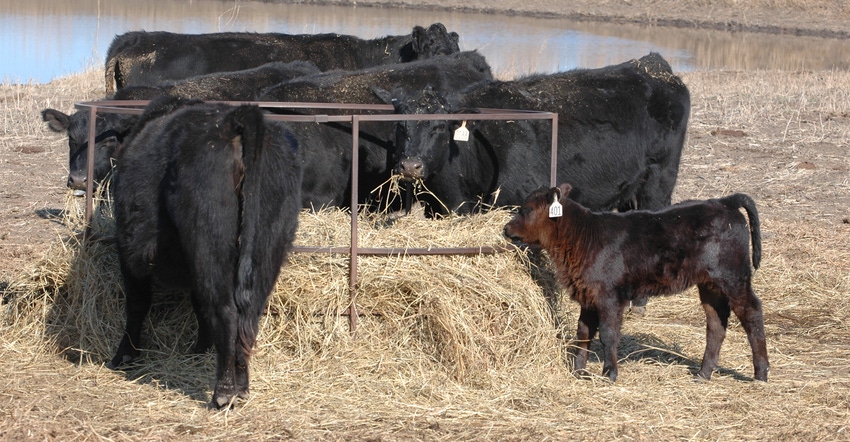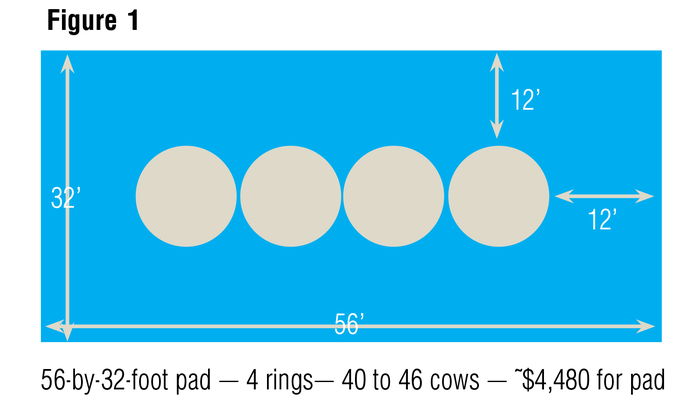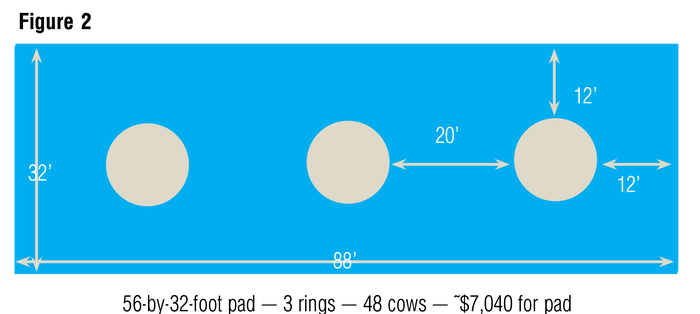Hay pads mean no more mud
Eliminate mud concerns in your winter feeding area with hay pads and limited access to hay.
December 2, 2019

The idea of making a hay pad was brought to my attention almost 20 years ago by Jason Tower, a former Purdue University animal science graduate student and current manager of the Southern Indiana Purdue Agricultural Center.
Tower’s initial job after his bachelor’s degree was as the farm manager at Hedgeapple Farm in Maryland. This farm used hay pads to eliminate the problem of mud around the hay feeders, which are heavy-use areas. Here’s how these pads are constructed:
Find a fairly level or gently sloping area with good drainage.
Scrape off any existing hay and manure, and remove around 8 inches of dirt.
Lay down geotextile fabric (a critical step to “hold” the rock and keep it separate from the soil).
Place around 6 inches of crushed stone (No. 53s) over the geotextile fabric.
Add around 4 inches of crushed limestone.
Drive over limestone with a tractor to pack the limestone. A few good rains will also help pack the lime prior to animal use.
Site selection for the feeding pad is crucial. Ultimately, it would be near the hay storage area and away from water, like streams and ponds.
If the site is level, the surface of the pad should be slightly higher at the center, gently sloping to all sides. If the site has a gentle slope, then the pad should follow the topography of the land and gently slope to one side. With a slope, the entrance and exit from the pad should be on the high side of the pad.
In general, there should be 10 to 12 feet of rock and limestone for the cattle to stand on around the bale feeder (Figures 1 and 2). The option of placing hay rings side by side will reduce the total footprint, saving money, but you must ensure there is enough bunk space for the entire herd to eat at the same time.
If square or rectangular hay feeders are used instead of round bale feeders, smaller hay pads can be used. A conservative cost estimate for construction of a feeding pad is $2.50 per square foot (material and labor costs will vary).
Maintenance of the feeding pad is necessary. Remove excess hay and manure, and add lime to the surface at least annually. Apply these nutrients to pastures or hayfields to maintain fertility levels.
In some cases, cost-share for building a hay pad is available. Check with your local Natural Resources Conservation Service (NRCS) for more specifics on selecting a site, building a hay pad and the potential for cost-share. A website with construction instructions can be found at bit.ly/buildhaypad.
Limit-feeding cows
Fifty years ago, beef cows were fed a finite amount of hay, typically delivered via small square bales. The number of cows was known, and the amount of hay they needed each day was calculated. Currently, a common way to feed cows is to allow 24/7 access to round bales of hay.
Therefore, 50 years ago, the owner was in charge of how much hay the cows received, and now the cows are in charge of how much hay is used. That might not seem like progress.
A system that works well with the hay pad is to place a single strand of electrified wire around the hay pad. Include a “spring gate” for the entrance and exit to limit access.
Research at Purdue showed that cows that had access to hay for only four or eight hours per day had 37% and 18% less hay disappearance, respectively, compared to cows with 24/7 access to hay — with no difference in cow weight change. Unlimited access to hay is almost never the most cost-effective ration.
In a situation where very high-quality hay is being fed, it is possible that access of four hours per head per day could provide all the energy and protein for a third-trimester cow. It is also possible that this same cow could be fed a more average-quality hay where eight hours per cow per day would be needed.
The key is to always test the hay for nutrient quality; and have your nutrition company sale representative, nutritionist, Extension beef specialist or veterinarian help to determine the ideal ration for your cows.
In much of the Midwest, there was a very wet spring, and first-cutting hay was harvested significantly later than normal. Overmature hay will likely be lower in energy and protein, and this hay will need to be supplemented with energy and protein. Testing hay now will pay huge dividends in your herd’s nutritional status.
For producers who find it inconvenient to let cows in and out of a hay feeding area each day so that cows only have four to eight hours’ access per day, there are technologies to make this chore easier. An online search led to gate-release timers and automatic gates.
The timer is set to open at a certain time, and the automatic gate is opened via a text message. A system like this could be a tremendous benefit to a producer who has an off-farm job.
In this case, cows could be automatically let into the hay feeding area at noon. When the producer arrives home at 6 p.m., the cows would be moved out of the feeding area, and the entrance and exit gate manually closed. The gate is then reset for automatic opening at noon the following day.
Economics of limit-feeding hay
If a 1,400-pound cow needs to consume 2.5% of her body weight in hay each day (35 pounds) and 24/7 access to hay results in a 28% hay wastage (10 pounds), that 10 pounds of hay can be saved every day. In a herd of 100 cows fed for 150 days during the winter where you limit access to six hours per day, your total hay savings per year is 75 tons. At $100 per ton, that is a savings of $7,500 per year.
If hay supply is short, you can program cows to spend less time eating hay and supplement them more. The same Purdue study mentioned above showed that cows will consume about 10 pounds of hay in one hour, around 16 pounds after two hours and around 25 pounds after four hours.
These times are based on average-quality hay, and as stated earlier, having hay tested and using a trusted adviser to help balance the ration is always recommended.
As an example, cows could be allowed two hours’ access to average-quality hay and fed 8.5 pounds of dried distillers grain per head per day to supply the cow’s energy and protein needs. Another advantage of this system is that the salt-mineral-vitamin mix can be topdressed onto the concentrate or coproduct feed.
This gives a much more uniform consumption of this product versus being fed free choice. To save an additional 5% to 10% of your hay, an ionophore should be included in the ration.
When asked, 100% of beef producers who have built hay pads and now use time feeding of cows say they would never go back to feeding in the mud or giving 24/7 access to hay. In fact, the most common response is, “I should have done this years ago!”
About the Author(s)
You May Also Like




.png?width=300&auto=webp&quality=80&disable=upscale)
